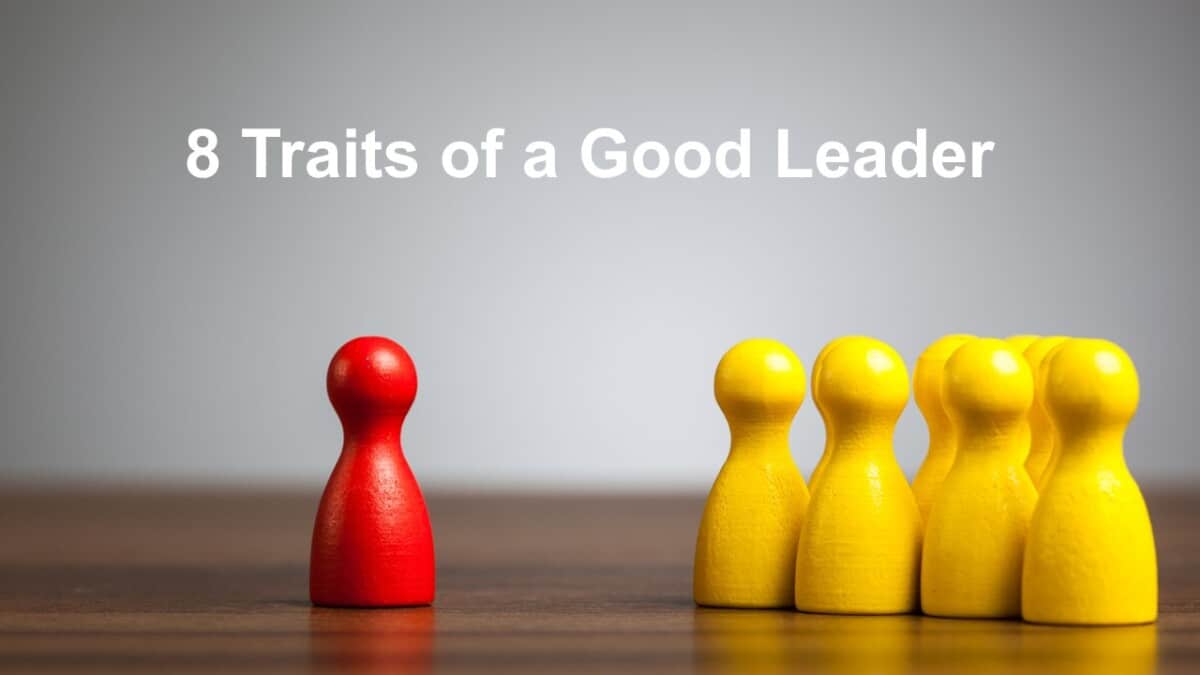Share:
Pamela Hackett, Contributor

From the workforce to an active war in Europe, the world is in a state of rolling shocks. To keep up, leaders are changing their business models and their operating models, but are they changing their leadership models?
Leaders must reconsider the traits people require of them today because the past no longer dictates the future. What was once necessary is no longer sufficient. There is a movement toward a different kind of leadership, one based on deeper human traits while balancing those that help leaders step up to a world in constant turmoil.
The leadership traits of today include a mix of new and old, but all must take on a new meaning in the context in which we now lead.
The eight traits of a good leader in today’s business world are self-awareness, connectivity, fairness, confidence, flexibility, improvisation, kindness, and taking it for the team. These traits engage, enable, and energize people to do great work.
This article explores the future of leadership and how these eight leadership traits create resilient teams that are equipped to perform well in the future.
The Future of Leadership: Good, Better, Best
In the past, good leadership was measured ultimately by results: revenues, profits, and productivity. Over time, this came to include the lag indicators that directly impact these three, including customer satisfaction and employee satisfaction. More recently, good leadership includes positive impacts on environment, social, and governance factors (ESG) and diversity, equity, and inclusion (DEI).
In 2020, leadership’s need for multi-stakeholder engagement hit the headlines with the Davos Manifesto and its description of the purpose of a company. It reads:
“The purpose of a company is to engage all its stakeholders in shared and sustained value creation. In creating such value, a company serves not only its shareholders but all its stakeholders – employees, customers, suppliers, local communities, and society at large. The best way to understand and harmonize the divergent interests of all stakeholders is through a shared commitment to policies and decisions that strengthen the long-term prosperity of a company.”
This requires a different kind of leadership. Even in the short time between the launch of the Davos Manifesto and now, the pressure on leadership to live this manifesto has grown, and with it the need for leaders to shift again and continue to be better.
The Great Leadership Challenge: Our Shocking World
With the end of the pandemic, the expected return to a buoyant economy did not arrive. Instead, a series of rolling shocks has continued.
We all know Russia’s invasion of Ukraine is not only a massive human tragedy but also an economic one. It has created further supply chain shocks, an energy crisis, inflation, and a cost-of-living crisis. Add to that cyber security issues, misinformation, and extreme weather events, as well as a return to reliance on fossil fuels that is causing climate initiatives to falter.
As the World Risk Report outlines, we’re entering a period of low investment, low growth, and low collaboration, underpinned by high levels of uncertainty, low levels of information, conflicting data, and cognitive bias. Wrapping that up into a ball of doubt, we are falling back on some of the basic human concerns—safety, food, water, energy, and security. This impacts how we lead.
Fueling that dark picture that leaders must navigate are the findings from the Edelman Trust Barometer 2023, describing the impact of the current levels of polarization. Alarmingly, few people would help, live near, or work with someone who disagrees with their point of view. In fact, only 20-30%. Additionally, only 40% of families believe they will be better off in the next five years.
And then there is everything we read about every day. Low levels of employee engagement, declining levels of wellness, and increasing levels of burnout and stress in the workplace.
We also have five generations at work and a highly diverse workforce, from Gen Z to Boomers, and the multicultural dynamics of a changing world. All of whom bring their own characteristics and requirements of leaders.
The Great Resignation showed people are no longer willing to work for poor people managers, companies that ignore societal needs (including the planet), or leaders who don’t show they care about them. Some reports show up to 60% of the workforce saying they would still change jobs if an opportunity arose. And, as for DEI initiatives, in some workplaces, it appears to be moving backward, particularly when it comes to women.
Together, this creates a perfect storm for leadership. It’s this world, or rather the impact this world is having on people, that leaders must now work with. And that, I would argue, takes a new kind of leadership.
The old ways won’t work. They haven’t yet. Productivity has barely improved in decades (since 2005, US labor productivity has grown at a lackluster 1.4% according to the folks at McKinsey), and that’s with the billions invested in new technology, training, and transformation projects. We need something else.
The New Leader Emerges and a Renewed Faith in Business
New leadership is required. One that really does truly put people before profits, if we want profits to ultimately flow.
Their report found the following: “Business is the only institution seen as competent and ethical… According to this year’s Trust findings, business remains the only trusted institution at 62%.”
There was also an additional shift. CEOs are seen to be obligated to improve economic optimism and hold divisive forces accountable. Much of this they put down to how businesses responded to the social and economic consequences of COVID-19 and Russia’s attack on Ukraine. A people-first approach.
Additionally, the business was capable of sharing a vision of the future, and how it plans to get there. Something the government has struggled to do.
I would argue, during these times new forms of leadership and leaders emerged, showing a different style, and breaking away from the past. When the chips were down, leaders stepped up. People, in return, supported them.
A Once in a Generation Opportunity
This is an enormous, yet precarious, opportunity. An opportunity for businesses and their management to continue to practice these new approaches and bring new leadership into the mainstream. One that is more human yet still balances the reality of today and the need to achieve results.
All this, at a time when inflation and economic shocks will cause many to revert to type and use solutions from their old playbooks and usual-suspect lists: layoffs, additional pressure, increasing responsibilities, and poor people skills.
None of this is about culpability, it’s mostly capability. Few if any leaders have managed or led through these times. Perhaps a few from the ’80s and ’90s and those that led through the financial crisis. But overall, this is uncharted territory for many.
So, what are the traits good leaders should be adding to their mindset at this historic point in time? No one has all the answers in this new world of work, but here are eight to consider:
Eight Traits of a Good Leader
1. Connectivity – “He has this amazing ability to connect the right people to solve problems. Relationships are really important to him.”
How effective are you at connecting to people, connecting people with other people, and connecting data? In a polarized world, this is a superpower combination—finding common ground through how you connect people and data.
Firstly, we need to connect more deeply with our people and teams than previously thought appropriate. Yes, you do need to know how people are feeling and, for example, what is happening at home. Without that, how will you know if they are able to perform at their best?
Second, your coaching and influence skills need to come to life routinely. This means coaching people on how to connect and collaborate with one another and using your influence skills to open the door to bringing people outside your control together for the greater good. People beyond your fence and at the fringes. This is an even greater challenge in a remote world.
Finally, you need to connect the dots on data to enable people to have access to one source of truth and then discuss it.
Here’s a quick test: Do you have one set of key numbers everyone follows, understands how they are reported, and who impacts the numbers at what point in the value chain?
2. Self-awareness – “She knows when she’s said the wrong thing and addresses it immediately.”
Ok. Nothing new here, right? It depends. Self-awareness in this new world takes two distinct paths.
One is your ability to see your impact on others. Are you engaging, enabling, and energizing people to do great work? Or are you getting in the way? Can you tell when what you say has a negative impact? Are you adding to the divisiveness or de-escalating the polarization by letting people use their voice and discuss maturely?
The other is your ability to see how your behavior is impacting yourself. Burnout. Stress. Anxiety. You set the stage for others. Are you aware of your own levels of engagement and energy?
Here’s a quick test: WAIT: The “Why Am I Talking” Test. If you’re taking up all the airspace, all the time, then this is a good place to start your self-awareness action plan—don’t take up 30% of the airtime at any one time.
3. Fairness – “She treats everyone with respect, brings everyone’s voice to the table, and allows them to have their say.”
You might think the old adage “life wasn’t meant to be fair” still stands true. Not so. Fairness is a great dis-engager. People will leave or quit and stay on the grounds of fairness.
There’s little point in having a highly diverse workforce or team if you don’t enable all the players to work together effectively, utilize their strengths, and ensure they have their own voice.
Diversity and inclusion are just ticking the boxes if you don’t know how to get the best out of the diverse minds you bring together. True inclusion is the ability to let all voices be heard and utilized.
Here’s a quick test: Ask your team members, one-to-one, if they feel they have a voice and if is it heard.
4. Confidence – “He is clear and concise in his communication. I know exactly what is needed and where we stand.”
Out the doubt. Nothing kills confidence like doubt. When silence is filled with gossip, when poor reporting confuses outcomes, when people say one thing but do another, it all causes doubt.
This means keeping your channels of communication open. Naturally checking in routinely. Explaining what you can and can’t discuss, and why. Having clarity. These assist people to feel more confident in you as a leader and the business.
Here’s a quick test: How do you spend most of your time? Color code your time. Assess what color your day is. How much of your day is spent in discussions with your teams? With the right conversations, you build confidence.
5. Flexibility – “She lets us know when we can brainstorm and debate versus when we need to move on and just get stuff done.”
In this context, flexibility is that trait that enables you to know when to be a formal leader and when to be flat. In other words, when to call the shots and when to back off and let your team determine the answers.
In this context, flexibility is that trait that enables you to know when to be a formal leader and when to be flat. In other words, when to call the shots and when to back off and let your team determine the answers.
Here’s a quick test: When you host a meeting, do you tell people if it is flat or formal? Do you explain whether it is a communication meeting for a decision that has already been made (formal) or a meeting to discuss options and debate the best course of action (flat)?
6. Improvisation – “He doesn’t stick to the plan if it’s not working. He experiments and prototypes new ways of working.”
Leaders who use scenario planning, who are comfortable with ambiguity, and who can lead through uncertainty, have become adept at improvisation. They look at the world through a different lens, collect data from various sources, gather people from different skill sets, and bring them together to identify different and new solutions to old problems.
Here’s a quick test: How curious are you? Do you look, listen, and learn before you lead? Are you genuinely interested in what others have to say? Do you allow debate and input from non-traditional sources or people outside your usual groups? Are you energized by debate or angered? These all build your improvisation muscle.
7. Kindness – “She has this empathy about her like she really understands people, so she knows where they’re coming from.”
Kindness is misunderstood as weakness much the same way empathy is. The two are almost interchangeable, and both are required traits in today’s world. They are a superstrength.
Kindness has a direct impact on results. It allows people to move forward. We’ve all been there when a misspoken, unkind word or action costs us an hour, a day, or a week of productivity. Unkind leaders neutralize team effectiveness.
Counter that with a random act of kindness and the positive impact that has on both the giver and receiver—a warm word when you needed it or someone showing they genuinely care. Kindness is a results-multiplier.
Here’s a quick test: Kindness doesn’t need you to do anything other than putting on someone else’s glasses for a time, so you can see the world how they experience it. We respond to people and situations much better when we understand more clearly what they are experiencing.
8. Taking it for the team – “He’s willing to take a loss for the good of the team or company. He doesn’t have to be the star.”
Falling on your own sword to enable others to shine shows the maturity and confidence of a good leader. They know that while their results may suffer, the results of the greater team will improve if they make a team decision rather than an individual decision.
This can mean anything from loaning that resource even when it may impact your area to giving a customer to another team because you know they are a better fit. Recognize that leadership is not a competition and that comparing yourself to other leaders is a race you can never finish.
Here’s a quick test: Do you have peer accountability, a leadership team trait that shows you are there for each other and not just your own team? If so, you won’t let your fellow leaders down, and you will deliver on the team outcomes above your own.
Humanize: The Not-So-Common Bond
These are just a few of the traits required of leaders today. Bundle them together, and it’s a focus on humanizing business that differentiates good leaders from the average.
When you treat leadership as a responsibility to your people and not just a company, you understand the human traits required of leaders. The traits that move people to do great work. The need to put people before profits as a guiding light in your decision-making, constantly asking, “Will this discussion or decision engage, enable, and energize people to do great work?”
You also understand the table stakes—the need to practice basic life skills—don’t cheat your people of their opportunities, don’t lie to them, and don’t steal their ideas.
While organizational structures have flattened their way into new forms, the role of the leader has never been more crucial for organizational success and results achievement. And, if you lead at the front line, you hold the success of your organization in your hands. You are the most valuable player. You directly impact people, for better or worse. Your behavior and actions count.
The challenges that lie before us as businesses and as leaders in the current age are unprecedented. No one has all the answers. Experience is all well and good, but it doesn’t outdo fresh thinking. We cannot try to get the old to fit the new.
Those businesses that prosper will require new models and ecosystems that synchronize with the business world and allow a new, more robust rhythm to achieve results and engage people in more meaningful ways. The traits leaders bring to their teams, and how their teams experience them as leaders, will determine their success.
It’s the ability of businesses to shift average managers to good leaders that will enable business results to improve. Improving average managers to be better leaders has a greater impact than an average improvement program.
The stakes have never been higher. As managers, we have a massive and direct impact on our teams and therefore our results, by how we behave. We need a new way of working. We need a new way of leading.

Pamela Hackett is a former CEO with over 35 years of experience working boots-on-the-ground with leaders and their teams. She is the author of the post-pandemic book for a new workplace Manage To Engage. How Great Managers Create Remarkable Results. Pam is on a mission to help leaders at every level better engage and improve their results. She is on a quest to help build organizations that are both fit and healthy. Productive and engaged. Leaders can make their numbers and have people who love coming to work.
Pamela has achieved the ‘first woman’ label for all her senior roles and has consulted for some of the world’s largest companies. She is a people-focused executive, motivated to engage leaders at every level so their teams can do great work and deliver value.


